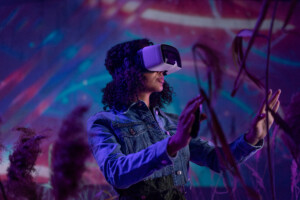Largely propelled by the rapid advancements in Artificial Intelligence (AI) and Virtual Reality (VR), the world of recruitment is in the midst of a massive shift. These technological strides are not merely supplementing traditional methods but are fundamentally redefining how organizations identify, engage, and onboard talent. The promise of a future where hiring practices are more efficient, inclusive, and engaging hinges on effectively harnessing these innovations. This article delves into the ways in which these technologies are currently being used, their potential, benefits, challenges, and how they are changing the future of hiring.
The Role of VR in Recruitment
Virtual Reality (VR) is redefining recruitment and candidate engagement, offering immersive experiences that were previously impossible, even unimaginable. Through virtual job previews and office tours, VR technology allows candidates, especially those considering remote roles or positions that necessitate relocation, to gain a firsthand understanding of the work environment and culture. This immersive insight is invaluable, helping candidates make well-informed decisions and ensuring a work-culture fit between the candidate and the organization.
The use of VR extends beyond engagement; it is revolutionizing the way skills and competencies are assessed. Candidates can perform tasks in virtual simulations that are directly related to the job, providing employers with a deeper insight into their practical abilities and problem-solving skills.[1] This new method of assessment allows for hiring decisions to be made based on demonstrable capabilities, ensuring they are closely aligned with job requirements.
In the aftermath of the COVID-19 pandemic, there has been a significant shift towards digital-first recruiting processes, encompassing the entire recruitment cycle from talent sourcing to onboarding.[2] Virtual recruiting enables companies to broaden their talent search geographically and tailor the recruitment experience, making it more engaging and inclusive. According to a recent survey, 65% of candidates are more likely to accept a role if they could first experience it through technology, such as VR.[2] This underscores the potential of VR to provide candidates with a comprehensive understanding of the job and company culture, thereby facilitating their decision-making process.
Streamlining Recruitment with AI
The integration of Artificial Intelligence (AI) into recruitment is marking a transformative era of heightened efficiency and a more engaging recruitment process. AI technologies are reshaping the landscape by automating the labor-intensive and time-consuming tasks traditionally associated with recruitment, such as resume screening and candidate sourcing. By efficiently examining hundreds of resumes in minutes and identifying candidates whose skills and experiences match the job requirements, AI significantly accelerates the hiring timeline. This technological advancement not only streamlines the recruitment process but also frees up recruiters to invest more time in personal interactions with candidates, thus elevating the overall recruitment experience.
One of the most significant benefits of AI in recruitment is its ability to foster diversity in the hiring process. AI-powered tools prioritize skills and qualifications over demographic information, playing a crucial role in minimizing unconscious bias.[3] This approach to unbiased recruitment is vital for building diverse teams, which are proven to boost innovation and creativity within organizations.
While AI in recruiting offers numerous advantages, such as reducing administrative workload, speeding up the screening process, diversifying talent pools, and enhancing the candidate experience, it is not without its challenges. The adoption of AI can lead to concerns about the loss of personal touch in recruitment, variability in candidate quality, and the need for substantial investments in technology and training. As noted by industry experts, the key to leveraging AI effectively in recruitment lies in selecting tools that align with an organization’s specific needs and thoughtfully integrating them into the existing HR technology stack.[4] This strategic approach ensures that AI not only simplifies the recruitment process but also enriches the quality of hires and maintains the human element crucial to successful talent acquisition.
Integrating AI and VR into Recruitment
For companies looking to adopt these technologies, the journey begins with setting precise goals—whether it’s to make the recruitment process more engaging for candidates or to streamline hiring tasks—and pinpointing the recruitment phases that will benefit most from VR and AI. This strategic planning is followed by a critical phase of selecting and procuring the right VR and AI solutions. It’s about finding the perfect match for the company’s unique needs, considering factors such as how well these technologies blend with existing systems, their scalability, and of course, the budget.
Once the right tools are chosen, the real magic begins with customization and integration into the company’s recruitment workflow. This involves tweaking VR to offer immersive job previews or crafting AI algorithms to sift through resumes more accurately. But it’s not just about plugging in new technology; it involves a thoughtful process of pilot testing, collecting feedback from real users, and making necessary adjustments.[5] To ensure a smooth transition, comprehensive training for recruiters and a phased rollout are crucial steps.
What truly keeps the integration process on track is continuous monitoring and the willingness to iterate based on performance data and user feedback. This approach doesn’t just transform recruitment into a more efficient and engaging process; it harnesses the transformative power of VR and AI to meet the dynamic needs of recruiting in the modern world, as explained in this exploration for an audience eager to understand the future of hiring.
Challenges and Ethical Considerations
The integration of AI and VR in recruitment, while advantageous, does raise significant ethical challenges, particularly concerning data privacy, algorithmic bias, and the digital divide. Ensuring the protection of personal data is incredibly important, necessitating strict adherence to data protection laws and transparent communication about data use. In addition, while AI has the potential to mitigate biases, it also may perpetuate existing biases, which highlights the need for continuous auditing and adjustment of algorithms, alongside maintaining human oversight in recruitment decisions.[6] Addressing the digital divide is crucial to prevent the exclusion of candidates lacking access to necessary technologies, ensuring opportunities are equitable across diverse socio-economic backgrounds.
Organizations are called upon to navigate these ethical situations with a commitment to transparency and integrity, setting standards that go beyond mere compliance with regulations. This involves clear guidelines on the ethical use of AI and VR, openness about the decision-making processes involving these technologies, and fostering an organizational culture that prioritizes ethical considerations. By tackling these challenges head-on and prioritizing ethical practices, companies can leverage AI and VR to enhance recruitment processes while safeguarding fairness, privacy, and inclusivity, ensuring that technological advancements serve to improve rather than undermine the integrity of the recruitment process.
Conclusion
The integration of AI and VR in recruitment is not just about adopting new technologies; it is about taking a leap forward to a future where hiring practices are more efficient, inclusive, and engaging. This future demands a responsible approach to technology, with a steadfast commitment to ethical practices and diversity. By doing so, we can forge a recruitment landscape that not only meets the technological advancements of our time but also reflects the values of equity and inclusiveness that are fundamental to the workforce of tomorrow.
Curious to learn more about harnessing AI in your hiring strategy? Talk to our experts about Radancy’s cutting-edge talent acquisition technology.
Sources
[1] Heaslip, E. (2022, May 30). 4 Big impacts of virtual reality in recruitment. Vervoe. https://vervoe.com/virtual-reality-recruitment/
[2] Lamm, J., & Adams, R. (2020, October 12). The new virtual reality of recruiting. PwC. https://www.pwc.com/us/en/services/consulting/business-transformation/library/new-virtual-reality-of-recruiting.html
[3] Trisca, L. (2023, December 29). AI in HR Examples: 9 Companies Successfully Using AI Innovation in Key People Processes. Zavvy. https://www.zavvy.io/blog/ai-in-hr-examples
[4] Korn Ferry. (2024). AI in Recruiting 2024: Pros and Cons. Retrieved from https://www.kornferry.com/insights/featured-topics/talent-recruitment/ai-in-recruiting-navigating-trends-for-2024
[5] McCann, A. (2023, September). How to use AI for recruitment. Workable. https://resources.workable.com/tutorial/ai-for-recruitment
[6] Kerry, C. F. (2023, July 7). How privacy legislation can help address AI. Brookings. Retrieved from https://www.brookings.edu/articles/how-privacy-legislation-can-help-address-ai/
















